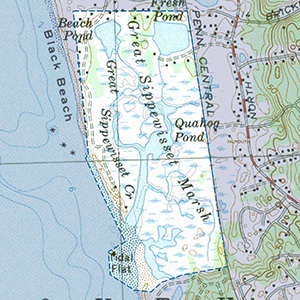Important Bird Area: Great Sippewisett Marsh and Black Beach
Site Summary
Nominated By
Rachel Farrell
Size
190 acres
Towns and Counties
Falmouth, West Falmouth; Barnstable
Ownership
Falmouth - Black Beach, nongovernmental organization
Major Habitats
60% salt marsh, 15% coastal beach, 25% marine/tidal
Land Use
wildlife conservation, tourism, fishing, undeveloped
IBA Criteria
- Category 1: Sites important for long-term research and/or monitoring projects that contribute substantially to ornithology, bird conservation, and/or education.
- Category 4: Sites containing assemblages of species characteristic of a representative, rare, threatened, or unique habitat within the state or region.
- Category 5: Single-species Concentrations: The site regularly supports significant concentrations of a flocking species, but may not meet the thresholds above. The site should support a higher proportion of a species' statewide population (more than 1%, if known) than other similar sites.
Site Description
Great Sippewissett Marsh is a large, typical, New England, tidal salt marsh situated behind two barrier beaches along the intertidal eastern shore of Buzzards Bay in Falmouth. Typical Spartina grasses, Saltwater Cord-grass and Tall Salt-hay, predominate this relatively unditched marsh. There are a number of salt pannes of various sizes and depths exposed at low tide, with two large salt pannes and two pools (Fresh Pond and Beach Pond) along the northern section of marsh. Two sand flats in the marsh interior are particularly attractive to shorebirds and resting gulls. Herons and egrets feed in the marsh daily during season, and small numbers of Great Blue Herons can be found throughout the winter. Black Beach is the northern barrier beach spit that separates Great Sippewissett Marsh from Buzzards Bay. The bay side of this beach, and the area to the south, consists of a broad intertidal zone with expansive tidal flats exposed at low tide. The southern barrier beach spit separating Great Sippewissett Marsh from Buzzards Bay is known as Saconessett Hills Barrier Spit. Great Sippewissett Marsh and Black Beach are sections of a larger area known as the Black Beach/Great Sippewissett Marsh District of Critical Planning Concern, in accordance with a Barnstable ordinance. Additionally, in 1990 this district was designated as a Wildlife, Natural, Scientific, and Ecological District; and a Hazard District.
Current Conservation Status
The southern terminus of Black Beach is a seriously eroded dune system. There are no known plans for actively controlling beach erosion at this site. There is a current proposal for beach nourishment along a private strip of beach in West Falmouth, adjacent to the town-owned Chapoquoit Beach, one-half-mile north along the coast. With continuation of present-day beach erosion, there is serious concern over the continued integrity and stability of the Black Beach dune system. Black Beach is an unsupervised sandy beach that receives intense recreational use during the summer months. Beachgoers arrive by foot and by boat, often with unleashed dogs. People and dogs on the tidal flats can disturb feeding shorebirds and resting terns. The town of Falmouth has received state funding to convert the unused railroad bed into an extension of the existing Shining Sea Bike Path. Foot traffic across the marsh will increase with the extension of this popular bike path, and this will undoubtedly exacerbate disturbance to birds in the marsh and on the tidal flats.
Ornithological Significance
The tidal flats on the bay side of Black Beach regularly provide habitat for a significant portion of the federally endangered Roseate Tern. This site has attracted up to 35 percent of the total population of Roseate Terns in Massachusetts (1,700 breeding pairs, 2002). During the breeding season, Roseate Terns and Common Terns utilize the flats for rest between feeding trips. Common Terns exploit the numerous baitfish in the tidal flow from the Great Sippewissett Marsh. Both Roseate and Common Tern adults feed their fledglings on these flats. Both species have been observed flying, with young in tow, to Black Beach from the nesting grounds on Ram and Bird Islands across Buzzards Bay. During migration, if plentiful baitfish conditions exist in Buzzards Bay, the tidal flats function as a staging area for concentrations of up to 3,000 to 4,000 mixed groups of Roseate and Common Terns, which can also include a few Least, Black, Forster's and, rarely, Arctic Terns. Until the early 1990s, Least Terns and Piping Plovers regularly nested at Black Beach. There is little evidence of recent nesting, possibly resulting from human and pet disturbance.
During late summer and early fall, up to 400 Laughing Gulls are regularly attracted to the Black Beach tidal flats and the sand flats in the Great Sippewissett Marsh. During the winter months, up to 150 Bonaparte's Gulls have been observed resting on these flats. Between 30 and 300 shorebirds are attracted daily to the flats during fall migration. Every year, several thousand swallows use this site as a premigratory staging area.The Great Sippewissett Salt Marsh Project is a long-term (30-year) ecosystem-level wetlands research project associated with the School for Marine Sciences at UMASS, Dartmouth. The project is directed by Brian Howes, and Dale Goehringer. The Great Sippewissett Marsh has also been used as a salt marsh model in numerous other education and research projects. The pools in the Great Sippewissett Marsh are attractive to wintering American Black Ducks. Two pairs of Ospreys and approximately six pairs of Saltmarsh Sharp-tailed Sparrows also nest in the marsh.
Other Flora or Fauna of Significance
The area is home to several state-listed rare and endangered species. The Massachusetts Natural Heritage and Endangered Species Program (NHESP) has designated and mapped the area as a "high priority site of rare species habitat and exemplary natural community" and noted the presence of two state-listed species: Piping Plover (threatened), Arethusa (threatened), and New England Blazing-star (special concernt). The US Fish and Wildlife Service (USFWS) has also identified the presence of a number of state and federally listed species within the area including the Least Tern (concern), Saltpond-grass, Rockrose.
Data Sources
Personal observations, Falmouth Wetlands Regulations Black Beach/Great Sippewissett Marsh DCPC is available online: http://www.buzzardsbay.org/falmdcpc.htm
Entire Falmouth Wetlands Regulations online: http://www.buzzardsbay.org/falmregs.htm




